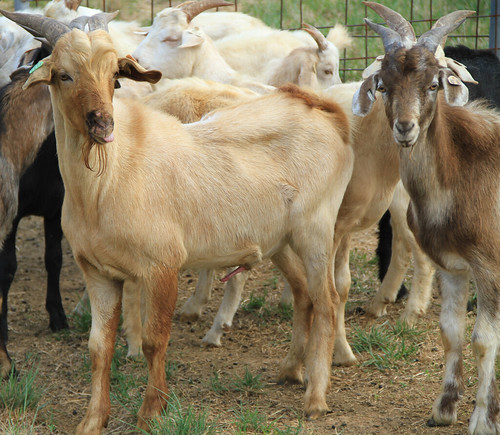 |
| Bucks waiting to be worked. |
Goats maintain weight in rut
For the past 14 days, total gain ranged from -3 to + 6 lbs and averaged 0.33 lbs. Average daily gain (ADG) ranged from -0.214 to 0.429 lbs. per day and averaged 0.024 lbs. per day.
Merritt Burke (DE) and Randy Allen (TN) had the top-gaining goats for the period. The low gain for the final weigh period is attributed to the "rut." The bucks are now quite "active" and odiferous.
For the 100-day duration of the test, the 67 goats gained between -0.010 and 0.240 lbs. per day and averaged 0.121 lbs. per day. Only one goat failed to post positive gain during the test.
Last year, the goats gained an averaged of 0.138 lbs. per day, but this was with considerably more forage. The goats did amazingly well this year when you consider the weather conditions and lack of forage. This is one "tough" bunch of bucks!
 |
| One of the top-gaining bucks for the period. 50% Kiko consigned by Merritt Burke (Delaware) |
At the same time, it is important to note that you cannot compare the goats from one year to another. Nor can you compare the goats in this test to the goats on another farm. The whole point of a central performance test is to equalize the environment so that the differences that are measured and observed can be attributed to genetic differences, not feed, management, or the environment.
For the duration of the test, the top-gaining buck remained Craig Adams' #2 Kiko buck. Two bucks tied for second highest rate-of-gain: Adams' #5 buck and a Kiko buck consigned by John Smith (VA): #63. Wes Pinneo's #51 buck has the next highest gain ratio. Three consigners have bucks that all gained above the test average: Wes Pinneo, Merritt Burke, and John Smith.
Internal parasites
FAMACHA© scores ranged from 1 to 3 and averaged 1.56, compared to 1.77 two weeks ago. Only one goat had a FAMACHA© score of 3. Obviously, no goats required deworming.
 |
| Good FAMACHA© scores. |
While the goats experienced some early parasite problems, due to existing pre-existing worm loads and ineffective anthelmintic treatments, the dry weather this year did not allow for a good evaluation (or comparision) of parasite resistance and resilience. The barber pole worm (and its relatives) require warmth and moisture to complete its life cycle. It is unlikely that the pastures contained high levels of infective worm larvae.
Fecal egg counts
For the fecal samples collected on September 9, fecal egg counts ranged from 0 to 1,825 eggs per gram of feces. Only six goats had fecal egg counts above 1,000 epg. No goats had fecal egg counts above 2,000 epg, the pathogenic burden of the barber pole worm. As in year's past, fecal coprocultures showed the worm burden to be almost 100 percent barber pole worm (Haemonchus contortus).
 |
| Fall grazing. |
Other scores
On the final day of the test, body condition scores ranged from 1.5 to 3 and averaged 2.36, unchanged from two weeks ago. Coat condition scores (2.07) and dag scores (1.05) were unchanged from two weeks ago. Only one goat showed any signs of scouring. While a few goats were treated for scours early in the testing period, dag scores tend to be a reflection of the moisture content of the forage. Dry forage = dry feces.
The goats continue to have access to all of the paddocks, as well as a round bale of grass hay.
Download September 23 (d-100) report











